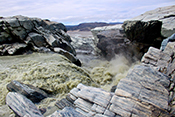 | The effect of warming climate on nutrient and solute export from the Greenland Ice Sheet Abstract: Glacial meltwater runoff is likely an important source of limiting nutrients for downstream primary producers. This has particular significance for regions surrounding the Greenland Ice Sheet, which discharges >400 km3 of meltwater annually. The Arctic is warming rapidly but the impact of higher discharge on nutrient export is unknown. We present four years of hydrological and geochemical data from a large Greenland Ice Sheet catchment that includes the two highest melt years on record (2010, 2012). Measurements reveal significant variation in dissolved solute (major ion) and estimated dissolved macronutrient (nitrogen, phosphorus and silica) fluxes, with increases in higher melt years. Labile particulate macronutrients dominate nutrient export, accounting for ~50 % of nitrogen and >80 % of both phosphorus and silica. The response of ice sheet nutrient export to enhanced melting is largely controlled by particle bound nutrients, the future supply of which is uncertain. We propose that the Greenland Ice Sheet provides an underappreciated and annually dynamic source of nutrients for the polar oceans, with changes in meltwater discharge likely to impact marine primary productivity in future decades. |
 | Environmental pressure from the 2014–15 eruption of Bárðarbunga volcano, Iceland Abstract: The effusive six months long 2014‒2015 Bárðarbunga eruption (31 August‒27 February) was the largest in Iceland for more than 200 years, producing 1.6 ± 0.3 km3 of lava. The total SO2 emission was 11.8 ± 5 Mt, more than the amount emitted from Europe in 2011. The ground level concentration of SO2 exceeded the 350 µg m−3 hourly average health limit over much of Iceland for days to weeks. Anomalously high SO2 concentrations were also measured at several locations in Europe in September. The lowest pH of fresh snowmelt at the eruption site was 3.3, and 3.2 in precipitation 105 km away from the source. Elevated dissolved H2SO4, HCl, HF, and metal concentrations were measured in snow and precipitation. Environmental pressures from the eruption and impacts on populated areas were reduced by its remoteness, timing, and the weather. The anticipated primary environmental pressure is on the surface waters, soils, and vegetation of Iceland. |
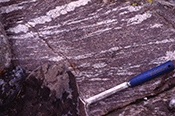 | Magnesium isotopic systematics of metapelite in the deep crust and implications for granite petrogenesis Abstract: Fluid-absent reactions that involve the breakdown of hydrous minerals produce granites in the continental crust. The minerals in the deep continental crust thus play a significant control on the chemical compositions of granites, but how and to what extent it may influence their isotopic signatures is poorly understood. Here we present Mg isotope data for a suite of amphibolite- to granulite-facies metapelites as well as the biotite and garnet minerals therein from the Ivrea Zone, NW Italy. The mineralogy of metapelites changes from biotite-dominated in the amphibolite-facies to garnet-dominated in the granulite-facies. The bulk Mg isotopic compositions (δ26Mg = -0.23 to +0.20 ‰) do not correlate with metamorphic grade, indicating negligible Mg isotopic variation caused by metamorphism of metapelites. By contrast, the δ26Mg values of biotite vary widely from -0.08 to +1.10 ‰, and increase with increasing metamorphic grade. Correspondingly, coexisting garnets become isotopically heavy (-1.22 to +0.10 ‰) as metamorphism proceeds, in order to equilibrate with the biotite, with a fractionation equation of 103 lnαbiotite-garnet = 0.96 × 106/T2, which can be used as a novel geothermometer. Our results indicate a nearly closed system for Mg isotopes of metapelites during metamorphism, and the bulk Mg isotopic compositions are therefore reconciled by the shifting garnet and biotite modes accompanied by increasing mineral δ26Mg values. The systematic Mg isotopic variation in the biotite and garnet implies a possible Mg isotope fractionation between melts and residues during biotite dehydration melting, which makes Mg isotopes a potential monitor of crustal melting and a tracer of granite petrogenesis. |
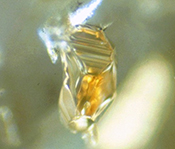 | Extreme 18O-enrichment in majorite constrains a crustal origin of transition zone diamonds Abstract: The fate of subducted oceanic lithosphere and its role in the planet-scale geochemical cycle is a key problem in solid Earth studies. Asthenospheric and transition zone minerals included in diamond have been interpreted as representing subducted oceanic crust based on inclusion REE patterns and strong 13C depletion of their host diamond (d13C as low as -23 ‰). This view/explanation, however, has been challenged by alternative interpretations that variable carbon isotopic compositions either result from high temperature fractionation involving carbides, or reflect primordial, unhomogenised mantle reservoirs. Here, we present the first oxygen isotope analyses of inclusions in such ultradeep diamonds – majoritic garnets in diamond from Jagersfontein (South Africa). The oxygen isotope compositions provide unambiguous evidence for derivation of the inclusions from subducted crustal materials. The d18OVSMOW values of the majorites range from +8.6 ‰ to +10.0 ‰, well outside that of ambient mantle (+5.5 ±0.4 ‰) and indicate that the protoliths were very heavily weathered at relatively low temperatures. When this information is combined with the broadly eclogitic composition of the majoritic garnets, a derivation from subducted sea-floor basalts is implied. Based on the association between the heavy oxygen and light carbon, the light carbon isotope composition cannot relate to deep mantle processes and is also ultimately derived from the crust. |
 | Copper isotope evidence for large-scale sulphide fractionation during Earth’s differentiation Abstract: The differentiation of Earth into a metallic core and silicate mantle left its signature on the chemical and isotopic composition of the bulk silicate Earth (BSE). This is seen in the depletion of siderophile (metal-loving) relative to lithophile (rock-loving) elements in Earth’s mantle as well as the silicon isotope offset between primitive meteorites (i.e. bulk Earth) and BSE, which is generally interpreted as a proof that Si is present in Earth’s core. Another putative light element in Earth’s core is sulphur; however, estimates of core S abundance vary significantly and, due to its volatile nature, no unequivocal S isotopic signature for core fractionation has thus far been detected. Here we present new high precision isotopic data for Cu, a chalcophile (sulphur-loving) element, which shows that Earth’s mantle is isotopically fractionated relative to bulk Earth. Results from high pressure equilibration experiments suggest that the sense of Cu isotopic fractionation between BSE and bulk Earth requires that a sulphide-rich liquid segregated from Earth’s mantle during differentiation, which likely entered the core. Such an early-stage removal of a sulphide-rich phase from the mantle presents a possible solution to the long-standing 1st terrestrial lead paradox. |
 | Time-lapse zirconography: Imaging punctuated continental evolution Abstract: The continental crust (CC) contains a 4.4 billion year record of Earth evolution (Armstrong, 1991; Bowring and Housh, 1995; Wilde et al., 2001; Harrison et al., 2005; Hawkesworth et al., 2010; Condie and Kroener, 2013). Understanding its growth is central to a broad range of research, including the geodynamics of the planet's interior (O'Neill et al., 2007; Korenaga, 2013), the evolution of the atmosphere (Barley et al., 2005) and even the evolution of life itself (Lowe and Tice, 2007). The growth of the continents is a competition between rates of crustal production and destruction (Armstrong, 1991; Hawkesworth et al., 2010), but whicfh of these dominates the CC record is debated. Here I examine a large database of detrital zircon U-Pb ages (n > 200,000; Voice et al., 2011) as a function of the age of the sedimentary rock in which they are found. This provides snapshots of the Earth's CC age distribution through time; in essence, producing a time-lapse movie of CC evolution. The analysis strongly indicates that the growth of the CC was episodic. |
 | Beyond the cellulose: Oxygen isotope composition of plant lipids as a proxy for terrestrial water balance Abstract: There is growing interest in using stable isotopes to measure the impact of shifting water regimes on terrestrial ecosystems. The analysis of oxygen isotopes (δ18O) of plant cellulose has been widely used for that purpose, but its application is limited by cellulose’s short life in most soils and sediments. Here we compare δ18O values of cellulose and plant lipids (hexane-extractable compounds) to assess the value of bulk lipids as a proxy for water balance. Using a set of field experiments with three C3 and three C4 species, we found significant differences in 18O enrichment in response to irrigation regime, with a strong linear relationship observed between cellulose and lipid signals. Imposed drought increased lipid δ18O values of all species relative to controls and also affected the carbon isotope composition (δ13C) of cellulose, reflecting increased water-use efficiency in C3 plants. Lipid extracts did not differ with respect to δ13C values, but δ18O signals consistently reflected drought effects in C3 and C4 species, regardless of variation in productivity and abundance of oxygen-containing functional groups. These results show that oxygen isotope composition of plant lipids can be used as a proxy for changing water regimes. |
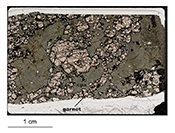 | Growth of upper plate lithosphere controls tempo of arc magmatism: Constraints from Al-diffusion kinetics and coupled Lu-Hf and Sm-Nd chronology Abstract: Most magmatism occurs at mid-ocean ridges, where plate divergence leads to decompression melting of the mantle, and at volcanic arcs, where subduction leads to volatile-assisted decompression melting in the hot mantle wedge. While plate spreading and subduction are continuous, arc magmatism, particularly in continental arcs, is characterised by >10-50 Myr intervals of enhanced magmatic activity followed by rapid decline (DeCelles et al., 2009). In some cases, such as the Andes, this pattern has recurred several times (Haschke et al., 2002). Abrupt changes in plate convergence rates and direction (Pilger, 1984) or repeated steepening and shallowing of subducting slabs (Kay and Coira, 2009) have been suggested as triggering flare-ups or terminating magmatism, but such scenarios may not be sufficiently general. Here, we examine the thermal history of deep crustal and lithospheric xenoliths from the Cretaceous Sierra Nevada batholith, California (USA). The deepest samples (~90 km), garnet-bearing spinel peridotites, show cooling-related exsolution of garnet from high-Al pyroxenes originally formed at >1275 °C. Modelling of pyroxene Al diffusion profiles requires rapid cooling from 1275 to 750 °C within ~10 Myr. Also suggesting deep-seated, rapid cooling is a garnet websterite from ~90 km depth with nearly identical Lu-Hf (92.6 ± 1.6 Ma) and Sm-Nd (88.8 ± 3.1 Ma) isochron ages to within error. Thermal modelling shows that this cooling history can be explained by impingement of the base of the Sierran lithosphere against a cold subducting slab at ~90 km depth, precluding cooling by shallowing subduction. Rather, the coincidence of the radiometric ages with the magmatic flare-up (120-80 Ma) suggests that the hot mantle wedge above the subducting slab may have been pinched out by magmatic (± tectonic) thickening of the upper plate, eventually terminating mantle melting. Magmatic flare-ups in continental arcs are thus self-limiting, which explains why continental arc magmatism occurs in narrow time intervals. Convective removal of the deep arc lithosphere can initiate another magmatic cycle. |
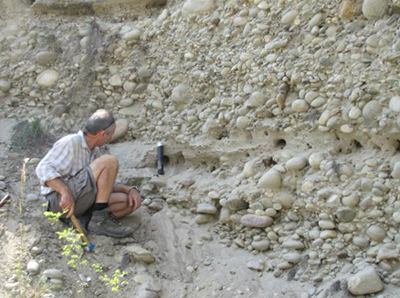 | Rapid response of silicate weathering rates to climate change in the Himalaya Abstract: Chemical weathering of continental rocks plays a central role in regulating the carbon cycle and the Earth's climate (Walker et al., 1981; Berner et al., 1983), accounting for nearly half the consumption of atmospheric carbon dioxide globally (Beaulieu et al., 2012). However, the role of climate variability on chemical weathering is still strongly debated. Here we focus on the Himalayan range and use the lithium isotopic composition of clays in fluvial terraces to show a tight coupling between climate change and chemical weathering over the past 40 ka. Between 25 and 10 ka ago, weathering rates decrease despite temperature increase and monsoon intensification. This suggests that at this timescale, temperature plays a secondary role compared to runoff and physical erosion, which inhibit chemical weathering by accelerating sediment transport and act as fundamental controls in determining the feedback between chemical weathering and atmospheric carbon dioxide. |
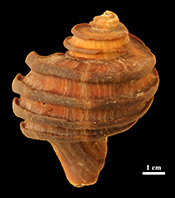 | Preserved macroscopic polymeric sheets of shell-binding protein in the Middle Miocene (8 to 18 Ma) gastropod Ecphora Abstract: The genus Ecphora of Muricid gastropods from the mid-Miocene Calvert Cliffs, Maryland is characterised by distinct reddish-brown colouration that results from shell-binding proteins associated with pigments within the outer calcite (CaCO3) portion of the shell. The mineral composition and robustness of the shell structure make Ecphora unique among the Neogene gastropods. Acid-dissolved shells produce a polymeric sheet-like organic residue of the same colour as the initial shell. NMR analysis indicates the presence of peptide bonds, while hydrolysis of the polymeric material yields 11 different amino acid residues, including aspartate and glutamate, which are typical of shell-binding proteins. Carbon and nitrogen elemental and isotopic analyses of the organic residue reveals that total organic carbon ranges from 4 to 40 weight %, with 11 < C/Nat < 18. Isotope values for carbon (-17 < δ13C < -15 ‰) are consistent with a shallow marine environment, while values for nitrogen (4 < δ15N < 12.2 ‰) point to Ecphora's position in the trophic structure with higher values indicating predator status. The preservation of the pigmentation and shell-binding proteinaceous material presents a unique opportunity to study the ecology of this important and iconic Chesapeake Bay organism from 8 to 18 million years ago. |
<< Previous issueNext issue >>





